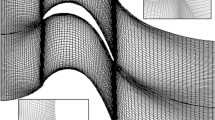Abstract
A three-dimensional steady incompressible viscous flow through a plane cascade of turbine blades has been analyzed through a numerical method based on the Navier-Stokes equation. Particular attention is paid to the prediction of secondary flows occurring due to the endwall boundary layer and the blade geometry. A standard k-ε model is used for the modelling of Reynolds stress and boundary-fitted coordinates are adopted to represent the complex blade geometry accurately. Two differencing schemes are applied to the convective terms to investigate the effect of numerical diffusion. Experimental data obtained for the flows through the Langston cascade are selected for code validation. Computed results for the velocity vectors and static pressure distributions are in good agreement with presious measurements and provide validity of this numerical method. Three-dimensional viscous flow phenomena and the distribution of total pressure loss caused by secondary flows are also reasonably well predicted.
Similar content being viewed by others
Abbreviations
- A w :
-
area of the control volume surface
- a :
-
coefficient of the discretized equation
- B :
-
product of the transformation matrix
- b :
-
transformation matrix
- C x :
-
axial chord of the airfoil
- C p :
-
pressure coefficient \( = (p - p_1 )/\tfrac{1}{2}\rho _1 q_1^2\)
- C pt :
-
total pressure loss coefficient \( = (p_n - p_t )/\tfrac{1}{2}\rho _1 q_1^2\)
- \(\overline C _{pt}\) :
-
mass-averaged total pressure loss coefficient
- C ε1, C ε2, C μ :
-
coefficients of the standard k-ε model
- E :
-
constant used in the law of the wall
- \(\vec e_x , \vec e_y , \vec e_z\) :
-
unit vectors in the Cartesian coordinate system
- F :
-
mass flux through the control volume surface
- f :
-
linear interpolation constant
- G :
-
production term in the turbulent kinetic energy, or the contravariant velocity
- J :
-
Jacobian
- k :
-
turbulent kinetic energy
- L :
-
characteristic length
- l + :
-
nondimensionalized vertical distance from the wall
- p :
-
pressure
- p t :
-
total pressure
References
Chan, D. C.; Sheedy, K. P. 1990: Turbulent flow modeling of three-dimensional turbine. AIAA paper no. 90-2124
Dorney, D. J.; Davis, R. L. 1992: Navier-Stokes analysis of turbine blade heat transfer and performance. ASME J. Turbomachinery 114: 795–806
Hah, C. 1984: A Navier-Stokes analysis of three-dimensional turbulent flows inside turbine blade rows at design and offdesign conditions. ASME J. Eng. Gas Turbines Power 106: 421–429
Langston, L. S. 1980: Crossflows in a turbine cascade passage. ASME J. Eng. Power 102: 866–874
Langston, L. S.; Nice, M. L.; Hooper, R. M. 1977: Three-dimensional flow within a turbine cascade passage. ASME J. Eng. Power 99: 21–28
Lee, D.; Knight, C. J. 1989: Evaluation of an O-H grid formulation for viscous cascade flows. AIAA paper no. 89-0207
Moore, J.; Adhye, R. Y. 1985: Secondary flow and losses downstream of a turbine cascade. ASME J. Eng. Gas Turbines Power 107: 961–968
Moore, J.; Moore, J. G. 1985: Performance evaluation of linear turbine cascade using three-dimensional viscous flow calculations. ASME J. Eng. Gas Turbines Power 107: 969–975
Moore, J.; Ransmayr, A. 1984: Flow in a turbine cascade: Part 1 — Losses and leading-edge effects. ASME J. Eng. Gas Turbines Power 106: 400–408
Moore, J.; Smith, B. L. 1984: Flow in a turbine cascade: Part 2 — Measurement of flow trajectories by ethylene detection. ASME J. Eng. Gas Turbines Power 106: 409–413
Patankar, S. V. 1980: Numerical heat transfer and fluid flow. McGraw-Hill, Inc.
Salvage, J. W. 1974: A review of the current concept of cascade secondary flow effects. von Karman Institute for Fluid Dynamics Technical Note 95
Sieverding, C. H. 1985: Recent progress in the Understanding of basic aspects of secondary flows in turbine blade passages. ASME J. Eng. Gas Turbines Power 107: 248–257
Spalding, D. B. 1972: A novel finite-difference formulation for differential expressions involving both first and second derivatives. Int. J. Num. Methods Eng. 4: 551
Author information
Authors and Affiliations
Additional information
Communicated by S. N. Atluri, 4 September 1993
Rights and permissions
About this article
Cite this article
Yoo, J.Y., Yun, J.W. Calculation of a three-dimensional turbulent cascade flow. Computational Mechanics 14, 101–115 (1994). https://doi.org/10.1007/BF00350278
Issue Date:
DOI: https://doi.org/10.1007/BF00350278




